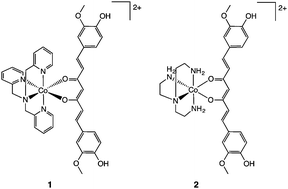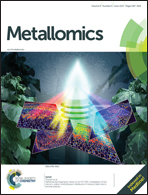Targeting curcumin to specific tumour cell environments: the influence of ancillary ligands†
Abstract
Tumour-activation of prodrugs has the potential to improve the efficacy of anticancer agents while minimising systemic toxicity. Cobalt complexes are of interest in this respect as chaperones to deliver and release anticancer agents in the low oxygen, reducing environment of solid tumours. In addition to being able to release a cytotoxic ligand under the conditions of the tumour microenvironment, it is fundamental that the chaperone complex must also be able to penetrate through multiple cell layers to deliver the cytotoxin to all regions of the tumour. Herein, we report an investigation of the distribution and metabolism of two chaperone complexes of the anticancer agent curcumin within monolayer tumour cells and multicellular tumour spheroids. Using a combination of X-ray fluorescence microscopy, confocal fluorescence microscopy, and X-ray absorption spectroscopy, we demonstrate how the nature of the chaperone complex can profoundly influence the cellular uptake, distribution, and release mechanism of curcumin, providing key insights into the design of this class of prodrug.



 Please wait while we load your content...
Please wait while we load your content...